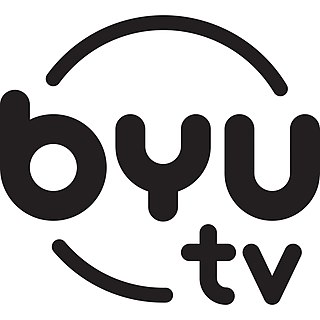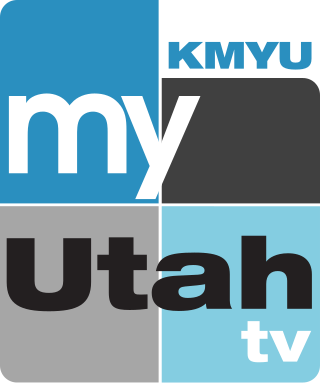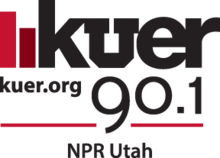
KSL Newsradio is a pair of radio stations serving the Salt Lake City, Utah region, consisting of the original AM station, KSL, licensed to Salt Lake City on 1160 kHz, and FM station KSL-FM, licensed to Midvale on 102.7 MHz. Owned by Bonneville International, a broadcasting subsidiary of the Church of Jesus Christ of Latter-day Saints, the stations share studios with sister television station KSL-TV in the Broadcast House building at the Triad Center in downtown Salt Lake City.

KSTU is a television station in Salt Lake City, Utah, United States, affiliated with the Fox network. It is owned by the E. W. Scripps Company alongside Provo-licensed independent station KUPX-TV. KSTU's studios are located on West Amelia Earhart Drive in the northwestern section of Salt Lake City, and its transmitter is located on Farnsworth Peak in the Oquirrh Mountains, southwest of Salt Lake City. More than 80 dependent translators carry its signal throughout Utah and portions of neighboring states.
KUED, branded PBS Utah, is a PBS member television station in Salt Lake City, Utah, United States. The station is owned by the University of Utah, and has studios at the Eccles Broadcast Center on Wasatch Drive in the northeastern section of Salt Lake City; its transmitter is located on Farnsworth Peak in the Oquirrh Mountains, southwest of Salt Lake City. KUED has a large network of broadcast translators that extend its over-the-air coverage throughout Utah.

KBYU-TV is a non-commercial educational independent television station licensed to Provo, Utah, United States, serving Salt Lake City and the state of Utah. The station is owned by Brigham Young University (BYU), an arm of the Church of Jesus Christ of Latter-day Saints. KBYU-TV's studios are located on the BYU campus in Provo, and its transmitter is located on Farnsworth Peak in the Oquirrh Mountains, southwest of Salt Lake City.

KUEN, known as UEN-TV, is an educational television station licensed to Ogden, Utah, United States, serving Salt Lake City and the state of Utah. The station is owned by the Utah Board of Higher Education and part of the Utah Education Network (UEN), which provides connectivity services to the state's K-12 and higher education systems. KUEN's studios are located at the Eccles Broadcast Center on the University of Utah campus; its transmitter is located at Farnsworth Peak in the Oquirrh Mountains, southwest of Salt Lake City, and is extended by dozens of broadcast translators across the state.
KLO-FM is a commercial radio station licensed to Coalville, Utah, and serving the Salt Lake City metropolitan area. It airs a classic alternative radio format, known as "103.1 The Wave," and it is owned by Capital Broadcasting. The station is the radio home for Weber State University sporting events. The radio studios and offices are at the 257 Tower in Downtown Salt Lake City.

KUCW is a television station licensed to Ogden, Utah, United States, broadcasting the CW network to Salt Lake City and the state of Utah. It is owned and operated by network majority owner Nexstar Media Group alongside ABC affiliate KTVX. The two stations share studios on West 1700 South in Salt Lake City; KUCW's main transmitter is located atop Farnsworth Peak in the Oquirrh Mountains, extended by dozens of translators that carry its signal throughout Utah and portions of Idaho, Nevada, and Wyoming.
KUUB is a non-commercial public radio station in Salt Lake City, Utah. It airs local news, talk and music programming, as well as network shows from American Public Media, Public Radio International, the Canadian Broadcasting Corporation and the BBC World Service. It broadcasts from studios at the Salt Lake City Public Library in Downtown Salt Lake City at Library Square.
KNKL is a contemporary Christian music radio station in Tremonton, Utah, United States. The station is owned and operated by the Educational Media Foundation (EMF) and broadcasts EMF's K-Love programming.

KMYU is a television station licensed to St. George, Utah, United States, serving as the MyNetworkTV affiliate for the state of Utah. It is owned by Sinclair Broadcast Group alongside Salt Lake City–based CBS affiliate KUTV and independent station KJZZ-TV. The stations share studios on South Main Street in downtown Salt Lake City; KMYU's transmitter is located atop Webb Hill, 2+1⁄4 miles (3.6 km) south of downtown St. George. Previously, KMYU-TV maintained separate studios in the J. C. Snow Building on East St. George Boulevard in downtown St. George, while KUTV's facilities only housed KMYU's master control and some internal operations.
KBYU-FM is a classical music radio station run by Brigham Young University in Provo, Utah. It is known on-air as Classical 89. It is a production of BYU Radio. It transmits at an effective radiated power of 32 kW. Its transmitting tower is located on a peak of the Oquirrh Mountains northwest of the university campus, and southwest of Salt Lake City.

The Utah Education Network (UEN) is a broadband and digital broadcast network serving public education, higher education, applied technology campuses, libraries, and public charter schools throughout the state of Utah. The Network facilitates interactive video conferencing, provides instructional support services, and operates a public television station (KUEN) on behalf of the Utah State Board of Regents. UEN services benefit more than 60,000 faculty and staff, and more than 780,000 students from pre-schoolers in Head Start programs through grandparents in graduate school. UEN headquarters are in Salt Lake City at the Eccles Broadcast Center on the University of Utah campus.

KRCL is a listener-supported community radio station in Salt Lake City, Utah, United States.

The Dolores Doré Eccles Broadcast Center is headquarters of three broadcast stations and a statewide educational consortium. The center houses KUED, KUER, KUEN and the Utah Education Network. The facility is northeast of the Jon M. Huntsman Center and southwest of the Huntsman Cancer Institute on the University of Utah campus in Salt Lake City.
KZNS is a commercial AM radio station in Salt Lake City, Utah. It airs a sports radio format and is owned by Jazz Communications LLC. Programming is simulcast on co-owned KZNS-FM 97.5, licensed to Coalville, Utah. On weekdays, KZNS-AM-FM have local hosts discussing Salt Lake City and national sports. Nights and weekends, programming is supplied by Fox Sports Radio. KZNS-AM-FM are the flagship radio stations for the Utah Jazz basketball team and the Salt Lake Bees Minor League Baseball team.

KMRI is an AM radio station which is currently silent, but previously broadcast a Regional Mexican format. Licensed to West Valley City, Utah, United States, the station serves the Salt Lake City metropolitan area. The station is owned by KRGO LLC. KRGO LLC is owned by communications attorney Barry Wood.
The 1958 Utah Redskins football team was an American football team that represented the University of Utah as a member of the Skyline Conference during the 1958 college football season. In their first season under head coach Ray Nagel, the Redskins compiled an overall record of 4–7 with a mark of 3–3 against conference opponents, placing fifth in the Skyline. Home games were played on campus at Ute Stadium in Salt Lake City. The Skyline Conference champions were led on the field by senior quarterback Lee Grosscup and junior safety and halfback Larry Wilson, a future member of the Pro Football Hall of Fame.
Doug Fabrizio is an American radio host and commentator. He is host of RadioWest, a popular talk show heard on KUER; RadioWest is syndicated by PRI, with a focus on the western United States and especially Utah.
Jennifer Napier-Pearce is an American journalist and former editor of The Salt Lake Tribune. She joined the Tribune in January 2013 as a business writer, before becoming host of the daily video program "Trib Talk" and the weekly radio news show "Behind the Headlines." She was named editor in August 2016. Prior to coming to the Tribune, Napier-Pearce was news director and reporter for KUER and KCPW.
KUSU-TV, VHF analog channel 12, was a non-commercial educational television station licensed to Logan, Utah, United States, which broadcast from 1964 until 1970. The station was owned by Utah State University. It went dark in 1970 as part of a consolidation plan to unify Utah's fragmented educational television landscape and replaced with a translator of KUED-TV in Salt Lake City.












